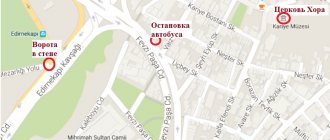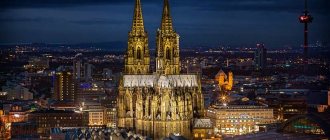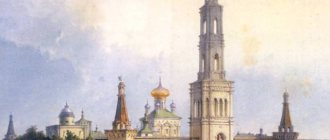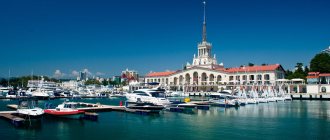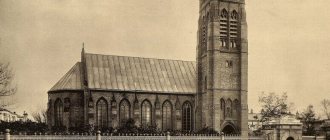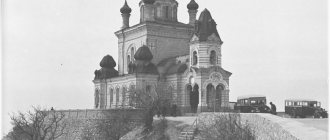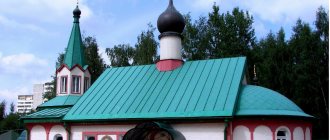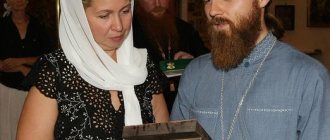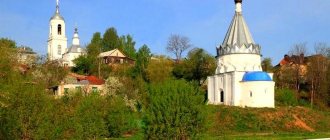| Bobruisk St. Nicholas Cathedral |
Bobruisk and Bykhov diocese
of the Belarusian Exarchate of the Moscow Patriarchate.
- Diocesan administration: Belarus, 213800, Mogilev region, Bobruisk, st. Karbysheva, 28, building 2
- Tel.: (+375, 47-32-38; fax: (+375 225) 58-50-99
- Official site:
- Canonical territory: Bobruisk, Bykhovsky, Glussky, Kirovsky, Klichevsky, Osipovichsky districts of the Mogilev region.
- Cathedral: St. Nicholas in Bobruisk
- On the map: Yandex.Map, Google map (no exact coordinates)
Established as the Minsk Vicariate.
The independent Bobruisk diocese of the Belarusian Exarchate was established by the Holy Synod of the Russian Orthodox Church on December 24, 2004, being separated from the Mogilev diocese.
Nowadays the Bobruisk diocese includes the southwestern regions of the Mogilev region. Cathedral city - Bobruisk.
Historical names
- Bobruisk and Osipovichi (December 24, 2004 - April 20, 2005)
- Bobruiskaya and Bykhovskaya (since April 20, 2005)
Statistics
- December 31, 2005 [1] - 35 parishes, 30 churches, 1 houses of worship, 3 chapels, 30 clergy. Population - 500,000 thousand people, of which 80% consider themselves Orthodox.
- 2007 [2] - parishes 35 [3], clergy 30. Population - 0.5 million people.
- OK. 2008 [4] – 36 parishes, 34 clergy.
- March 2012 - 53 parishes, 48 churches, 40 clergy (38 priests; 2 deacons), 2 monasteries [5]
Geography of deaneries
- Bobruisk city:
- Bobruisk
- g.p. Glusk, Vorotyn village, Malye Bortniki village, Turki village
- Bykhov, Barkolabovo village, Mokroe village, Chechevichi village
- Kirovsk, Klichev, Borki village, Lyubonichi village
- Osipovichi, Daraganovo, Lapichi, Svisloch
Bobruisk diocese: History of persecution
In the twentieth century, one can trace four waves of repression aimed at the clergy and believers: three before the Great Patriotic War and one post-war...
The first wave is associated with the tragic events of the first post-revolutionary years. Terror fell on the church as the custodian of the “old” foundations. Local reprisals against clergy, confiscation of valuables, and desecration of churches and Orthodox shrines were encouraged in every possible way. Characteristic of that time was the almost complete absence of written evidence of repression. This is explained by the fact that the repressive machine of the Cheka has not yet had time to develop at full power. There was no clear plan of action, numerous raids were not always recorded, and the activities of individual “activists” were downright predatory in nature and were not coordinated by anyone. However, the absence of evidence does not mean that persecution did not occur.
Bobruisk and its environs relate to the testimony of modern researcher I. I. Yanushevich: “The frontline zone, frequent changes of regimes, constant hostilities ... - all this gave reason to accuse almost any clergyman of counter-revolution. Clerics were arrested, interrogated, and some simply disappeared.” The period of the first wave of persecution can be defined approximately as follows: from 1917 to 1921, when the Riga Peace Treaty was concluded on the division of the republic into Western and Eastern Belarus. The Bobruisk diocese entered entirely into the Eastern part.
Conventionally, the beginning of the second wave of repression can be considered the beginning of the thirties. However, the twenties were not calm either. All this time, there was a frenzied campaign to discredit the church and clergy, intrigue, confiscation of valuables, provocations, and show trials. The authorities initiated the Renovationist split in every possible way. At the same time, at this time the Soviet state tried to create an image for itself in the world community, opened diplomatic missions, and listened to the opinions of the foreign public. A new economic policy was announced, leading to a temporary liberalization of social relations. In this regard, punitive authorities tried to avoid high-profile trials against clergy. Among the names of 106 clergy identified by the diocesan commission for canonization, only a few date back to the period before the early thirties. Here are examples of such destinies.
Mark Petrovich Medvedev , born in 1888, native of the village. Sharpilovka, Dyatlovo district, Gomel region, Belarusian, peasant, married. Hieromonk. Until 1905 he was engaged in agriculture, in 1905 he went to the Kiev monastery and stayed there until 1908, after which he moved to the monastery of Baltu-Kamenets, Podolsk province. In 1920, after the monastery was closed, he left for his homeland in the village. Sharpilovka. By appointment of His Grace Bishop Tikhon of Gomel, he served as a priest for two and a half years in the village of Strumen, Kormyansky district, Mogilev region. He moved to the village of Parkhimkovichi, Kharlapovichi village council, Bobruisk district, and served there as a priest. At the time of his arrest, he lived in the village of Parkhimkovichi. Arrested on June 4, 1928 by the Bobruisk OO of the GPU of the BSSR for “anti-Soviet agitation.” By resolution of the Special Meeting of the OGPU Collegium on August 24, 1928, he was sentenced to three years of deportation to Siberia. He did not return from the camps. Rehabilitated on October 29, 1992 by the prosecutor's office of the Mogilev region.
Alexander Manuilovich Shelepin was born on January 4, 1874 in the village of Starye Dvoryaninovichi, Bobruisk district. He graduated from the Minsk Theological Seminary (1895), ordained a priest (1900). He served as rector of the Holy Trinity Church in the village of Nacha, Borisov district, Minsk province, now Krupsky district of the Minsk region, of the Holy Intercession Church in the village of Polyany, Igumen district of the Minsk province, now Pukhovichi district of the Minsk region. In the mid-1920s he served in the Holy Protection Church in the village of Salamareche (now Minsk district). He was married and had a child. Arrested on May 8, 1929 in the village of Kaloshchitsy, Minsk region. Convicted on June 18, 1929 by a special meeting of the OGPU for “anti-Soviet agitation” to three years in the camps. Conveyed to the Solovetsky camp of the OGPU of the Karelian Autonomous Soviet Socialist Republic. Further fate is unknown. Rehabilitated on March 26, 1992 by the prosecutor's office of the Minsk region.
Ivan Semenovich Shimanovsky was born in 1866 in the village of Lyubyaz, Pinsk district, Minsk province. From the family of a clergyman. He graduated from the Minsk Theological Seminary and was ordained a priest (1892). Since 1893 - rector of the St. John the Theological Church in the village of Mikhalevo, Bobruisk district. Arrested on September 21, 1929 in his native village. Convicted by the NKVD board on December 1, 1929 for “spreading provocative rumors” to three years in prison with confiscation of property. Sent to Siberia. Further fate is unknown. Rehabilitated on November 19, 1992 by the prosecutor's office of the Mogilev region. Father John is still remembered as a good shepherd by local residents.
As can be seen from the data presented, the sentences are still short, but the facts indicate that the shepherds have not returned to their families and their flock. Both in these cases and in many subsequent ones, the wording “further fate is unknown” means one thing: the person perished in the bowels of the Gulag.
The second wave of persecution is defined within the period 1930-1933. At this time, the internal party struggle ended with Stalin's victory, and a course was set for the most severe centralization of power and the elimination of the slightest signs of opposition. The church was on the list of enemies of the regime. Here is information about some of the clergy who suffered during this time.
Konstantin Stepanovich Adamovich was born in the village of Yanovo, Minsk district, now the Volozhin district of the Minsk region. From a peasant family. Before his arrest, he was a deacon of the Holy Trinity Church in the village of Telusha, Bobruisk district. He was married and had two children. Arrested on December 29, 1932. He was involved in the same case with active parishioners Joseph Bury (b. 1895), Nikolai Dudal (b. 1891), Sergei Dudal (b. 1891), Taras Lavrinovich (b. 1896), Efim Stupen ( born 1882). All were convicted on March 5, 1933 by the OGPU board for “participation in a counter-revolutionary kulak-priest organization” and sentenced to capital punishment with confiscation of property. Shot in Mogilev, in the NKVD prison. Rehabilitated on May 27, 1960 by the judicial panel of the Supreme Court of the BSSR.
Fyodor Stepanovich Aliznyuk (b. 1875). Priest. Before his arrest, he was the rector of the Peter and Paul Church in the village of Batsevichi (at that time postal address: Svisloch station) of the Bobruisk district of the Minsk province, now the Klichevsky district of the Mogilev region. Arrested on May 16, 1932. Sentenced in June 1932 to five years in the camps. He did not return from the camps. Rehabilitated on October 31, 1989.
Viktor Vikentyevich Miklush (b. 1876, village of Bluzha, Igumen district, Minsk province, now Pukhovichi district, Minsk region). From a peasant family. Before his arrest, he was the rector of the assigned church in the village of Selishchi, now the city of Kirovsk, Mogilev region. He was married and had four children. Arrested on February 23, 1933. Convicted on April 21, 1933, together with other active parishioners (about ten people in total) by the OGPU collegium for “anti-Soviet agitation”, sentenced to capital punishment with confiscation of property. Shot. Rehabilitated on June 17, 1961 by a decision of the Presidium of the Mogilev Regional Court.
Alexander Maksimovich Runkevich was born in 1891 in the town of Klichev, Igumensky district, Minsk province, now the regional center of the Mogilev region. Priest. His father Maxim Vasilyevich Runkevich was the rector of the Holy Trinity Church in Klichev from 1883 to 1927. Alexander Runkevich graduated from the Minsk Theological Seminary (1914), and was sent as a psalm-reader to the Peter and Paul Church in the village of Golynka, Slutsk district, Minsk province, now the Kletsk district of the Minsk region. On April 25, 1915, he was transferred to the Peter and Paul Church in the village of Novoselki, Slutsk district, now Kopyl district. Ordained a priest. Since 1916 - rector of the Assumption Church in the village of Kosino, Borisov district, Minsk province, now Logoisk district. In the 20s he served in the Peter and Paul Church in the village of Belevichi, Slutsk district, now Slutsk district. Since 1927 - rector of the Holy Trinity Church in Klichev. He was married and had two children. Arrested on January 17, 1930. Convicted on February 23, 1930 by the NKVD troika for “anti-Soviet agitation” to five years in the camps. He did not return from the camps. Rehabilitated on July 7, 1989 by the Mogilev Regional Prosecutor's Office.
Parfen Ivanovich Skripunov was born in 1881 in the village of Skriplitsa, Bobruisk district, now Kirov district. From a landowner's family. Before his arrest, he was the rector of the church in his native village. Arrested on February 10, 1930. Convicted on February 23, 1930, together with the priest Lazar Chistobaev, by a special meeting at the OGPU for “terrorist and anti-Soviet activities.” Sentenced to capital punishment. Both were shot. Together with Parfen Skripunov, his brothers Kirill (b. 1896) and Ananiy (b. 1880) were convicted - sentenced to capital punishment, Panfil (b. 1887) - to 10 years in the camps. Parfen Skripunov was rehabilitated on June 9, 1989.
Spiridon Andrenko (monk Spiridon) was born in 1877 in Bykhov, now the regional center of the Mogilev region). From the brethren of the Kiev-Pechersk Monastery. Arrested on May 5, 1932. He was involved in the same case with priests Vasily Gandin, Pallady Katrenko, Evstratiy Motlakhov, Valentin Nikolenko, Hieromonk Pimen (Lebed), nuns Maria (Kuleshova), Marina (Starovoytova), active parishioners: paramedic Pyotr Razumovsky (b. 1887), peasants -individual owners Semyon Avtushkov (b. 1892), Prokofia Baranova (b. 1906), Ulyan Baranovsky (b. 1891), Daria Drozdova (b. 1897), Domna Emelianenko (b. 1887) ) Prokofia Emelianenko (b. 1890), Platon Kovsh (b. 1880), Afanasy Mazalovsky (b. 1867), Matryona Malashenko (b. 1877), Stepan Mironov (b. 1877) , Vladimir Puzikov (b. 1891), Elisey Smolyakov (b. 1888). Sentenced by the OGPU board on September 3, 1932 for “anti-Soviet agitation and propaganda” to five years in the camps. Further fate is unknown. Andrenko was rehabilitated by the Supreme Court of the BSSR on January 16, 1989.
Apparently, the last case is related to the destruction of the Barkolabovsky monastery that took place around the same time. The general observation of the situation is this: along with the old methods - giving short sentences for the sake of beheading the community in Bobruisk district - the first execution sentences appear. Another observation is that group cases appeared, security officers allegedly identified conspiracies to overthrow and discredit the Soviet regime. Thus, the parish was not just intimidated, but completely destroyed with the aim of exterminating any sprouts of faith in the future. This tactic will fully make itself felt later, at the end of the thirties, when the state machine of destruction begins to work at full power.
The third wave of repression hit the church in 1937-38. At this time, 38 of the 106 clergy who were repressed within the Bobruisk diocese suffered.
After Stalin’s article “Dizziness from Success” and the purge of the OGPU, believers began to hope that the endless night of repression would end. Between the third and fourth waves, the Stalinist Constitution was issued, formally declaring freedom of conscience. But this was just the calm before the storm.
The repressions of this time have no analogues in world history. Hundreds and thousands of urban and rural troikas (organs of extrajudicial criminal prosecution of the NKVD), consisting of illiterate and cruel people, wrote monstrous sentences as carbon copies, which were immediately carried out. These are the fates of the priests.
Ivan Nikolaevich Albov (born January 16, 1882 in the town of Markovo, Vileika district, Vilna province, now Molodechensky district, Minsk region). From the clergy. He graduated from the Lithuanian Theological Seminary and was ordained a priest in 1908. He served in the St. Nicholas Church in the village of Lebeda, Lida district, Vilna province, now Lida district, Grodno region. On October 3, 1914, he was transferred to the Holy Cross Church in the town of Delyatichi, Novogrudok district, Minsk province, now Novogrudok district, Grodno region. Since 1915 he served in the St. Nicholas Cathedral in Bobruisk. Since 1923 - rector of the assigned church of St. Mary Magdalene at the religious women's school in the town of Parichi, Bobruisk district, now a village in the Svetlogorsk district of the Gomel region, where he served until 1926. In 1930 he returned to Bobruisk and continued his ministry. Using his own funds, he built a church in honor of the Dormition of the Mother of God, which was soon taken away by the authorities and rebuilt as a clinic. Arrested on August 4, 1937 by the Bobruisk Regional Department of the NKVD of the BSSR for “counter-revolutionary activities.” At the time of his arrest, he lived in Bobruisk. Convicted on September 17, 1937, together with priests Vasily Goryachko, Grigory Runkevich and active parishioners Fyodor Bakhanovich (b. 1876), Khrisanf Gorbachevsky (b. 1876), Felix Rinevsky (b. 1878), Vladimir Turban (1878) b.), Meyer Khozanov (b. 1881), Nikolai Valko (b. 1887, headman of the Holy Assumption Church, built by Father John Albov) and sentenced to capital punishment with confiscation of property. The sentence was carried out on September 28, 1938 in Bobruisk - everyone was shot. Ivan Albov was rehabilitated on September 3, 1960 by the Mogilev Regional Court.
Pavel Nikolaevich Sevbo (b. 1883, Telusha village, Bobruisk district), priest. He graduated from theological seminary and was ordained a priest. He served in the Mogilev diocese. Arrested on December 10, 1937 in the village of Khoroshoe, Bobruisk district. Convicted by the NKVD troika on February 16, 1938, together with other active parishioners, for “anti-Soviet activities” and for “participation in a counter-revolutionary kulak organization”, sentenced to capital punishment with confiscation of property. Shot. Rehabilitated on April 23, 1960 by the Mogilev Regional Court.
His relatives living in Bobruisk told a lot about Father Pavel. He worked as a teacher for a long time, even then trying to instill in children a love for the Orthodox faith and the church. He was arrested several times and was once detained for three months. Before his arrest, he refused to renounce his priesthood. He was under investigation for three months; they tried to incriminate parishioners for creating an “anti-Soviet group.” But in the case of Father Pavel, the investigators failed to concoct a “counter-revolutionary organization.”
Mark Fedorovich Tium-Bufalov was born on April 25, 1885 in the village of Khilmanovtsy, Volkovysk district, Grodno region, Belarusian, from a peasant background, literate, married. Servant of the Chigirin Church. In 1906 he graduated from the teachers' seminary, and until 1914 he taught in the Grodno province. From 1914 to 1918 he served in the tsarist army. From 1918 to 1924 he taught in the Yenisei province (Siberia). Upon returning to his homeland, in 1925, he received the position of psalm-reader in the city of Klichev. In 1930, he was ordained by His Grace Joasaph, Bishop of Mogilev, as a deacon with an appointment to the village of Blagovichi, Chausy region. Having received a new appointment, he began to serve as a deacon in the Nichiporovichi church in the Shklov region. In 1930 he was ordained a priest of the same church. In 1931 he was transferred as a priest to the Chigirin Church in the Kirov district of the Mogilev region. In 1929, we were tried by the Klichev People’s Court for “going to prayer” and acquitted in court. Arrested on July 17, 1937 by the Kirov RO NKVD of the BSSR for “agitation directed against collective farm construction.” At the time of his arrest, he lived in the village of Chigirinka, Kirovsky district, Mogilev region. By a resolution of the meeting of the NKVD troika of the BSSR dated August 7, 1937, he was sentenced to 10 years in forced labor camps. He did not return from the camps. Rehabilitated on April 26, 1989 by the prosecutor's office of the Mogilev region.
Fedor Leontievich Shustov was born in 1882 in the village of Zarechye. In 1912 he left for the USA and worked in New York. In 1922 he returned to his homeland and served at the church. In 1929 he was ordained a priest. In 1935 he was sentenced to two years in camps in the Orenburg region. Upon his return, he served in the village of Grodzianka, Osipovichi district. Arrested on August 26, 1937. According to the testimony of the GB authorities, in the investigation reports in the case of Father Fyodor Shustov, Father Ioann Albov, Father Pavel Sevbo and Nikolai Valko, there are no facts of voluntary renunciation of faith, admission of guilt or slander of anyone during interrogations.
After 1938, the Orthodox Church in Belarus in general and in the Bobruisk diocese in particular lay in ruins. Priest Fyodor Krivonos writes about this: “A sad, gloomy timelessness came in the lives of believers... Those who remained free no longer had the opportunity to visit the temple of God. Only in Bobruisk until June 24, 1939, the small cemetery church of St. Sophia still continued to operate.”
What happened after the end of the war gives rise to talk about a fourth wave of repression.
12 out of 106 clergy who suffered under Soviet rule were repressed at this time. Here are the typical destinies.
Alexander Petrovich Antonikovsky (b. 1887, village of Gorbatsevichi, Bobruisk district). His father Peter Antonikovsky from February 28, 1885 to 1900 served as rector of the Church in honor of the Placing of the Robe in the village of Gorbatsevichi. Alexander Antonikovsky graduated from the Minsk Theological Seminary and was ordained in 1911. He was married and had a child. During World War II he served in occupied territory. Arrested on July 17, 1944 in Minsk. Convicted on September 9, 1944 for “collaboration with the German occupation authorities”, sentenced to three years in the camps with confiscation of property. Further fate is unknown. Rehabilitated on November 30, 1989 by the Plenum of the Supreme Court of the USSR.
Nikolai Matveevich Gurinovich was born on September 7, 1908 in the town of Ilye, Vilna district, Vilna province, now Vileika district, Minsk region. Priest. From the family of an employee. He graduated from the Vilna Theological Seminary (1929), the Faculty of Theology of the University of Warsaw (1934). Master of Divinity (1937). On September 29, 1933 he married Zinaida Aleksandrovna Bazhko (born in 1912). On November 6, 1933, Bishop Savva (Sovetov) ordained him a deacon, and on February 11, 1934, he was ordained a priest of the Nicholas Academic Church in Warsaw. On March 6, 1934, he was appointed rector of the missionary parish of the village of Golla, Warsaw-Kholm diocese, now the territory of Poland. Since December 12, 1934 - rector of the Church of the Nativity of the Virgin Mary in the village of Okhva, now Pinsk district of the Brest region. From February 12, 1936 - the Nativity of the Theotokos Church in the village of Velyachitsy, now Pinsk district. In 1937-39 - teacher at the state gymnasium and lyceum in Pruzhany, Brest region, second priest of the Pruzhany Alexander Nevsky Cathedral. On January 15, 1940, Metropolitan of Minsk and Belarus Panteleimon (Rozhnovsky) appointed rector of the united Gruzdovo-Polochano-Khozhevsky parish, now Molodechensky district of the Minsk region. He was married and had two children. During World War II he remained in occupied territory. Arrested on January 12, 1945. Convicted on April 30, 1945 for “collaboration with the German occupation authorities and anti-Soviet activities”, sentenced to 20 years in the camps and five years of “defeat of rights” with confiscation of property. Transferred to the Vorkuta concentration camp of the NKVD of the Arkhangelsk region. Released on January 10, 1956. On February 14 of the same year he was appointed rector of the St. Nicholas Church in the village of Telusha, Bobruisk district, Mogilev region, on July 31, 1956 - of the Holy Trinity Church in Khotimsk, Mogilev region, on October 10, 1958 - of the Holy Trinity Church in Bykhov, Mogilev region, from 8 December 1958 serves in the Stefanovo Church in Kotlas, Arkhangelsk region, Russia. Died in 1980.
Igor Dmitrievich Zeleznyak (born May 10, 1913 in the village of Novaya Ushitsa, now Khmelnitsky region of Ukraine). Priest. From the family of a clergyman. Graduated from the Pinsk Gymnasium, Faculty of Theology of the University of Warsaw (1935). He served as a psalm-reader in the Church of the Nativity of the Virgin Mary in the village of Saturday, now Drogichinsky district of the Brest region, then in the Intercession Church in the village of Kamen Shlyakhetsky, from 1939 - in the Church of the Intercession in the village of Oktyabr, now Kobrin district of the Brest region. On February 22, 1936, Archbishop Alexander (Inozemtsev) of Pinsk ordained him a priest and assigned him to the St. Nicholas Church in the village of Ostromechevo, now Brest district. Since 1937, he served in the St. Nicholas Church in the village of Bolshiye Sekhnovichi, now Zhabinkovsky district of the Brest region. He was married and had four children. During the war he was in occupied territory. Since 1944 - the second priest of the Brest Simion Cathedral. Arrested on August 27, 1945 in Brest. He was under investigation in the internal prison of the Brest Region KGB. Convicted by the military tribunal of the Brest Region Ministry of Internal Affairs troops.
On July 13, 1946, for “participation in an anti-Soviet counter-revolutionary nationalist organization” (Article 63-1 of the Criminal Code of the BSSR), he was sentenced to 10 years in the camps and three years of loss of rights. Since 1952 - rector of the St. Sophia Church in Bobruisk. Since 1955 - in the Church of the Intercession in Dzerzhinsk, Minsk region. Since 1965 - priest of the Intercession Cathedral in Baranovichi, Brest region. Since 1966 - in the church in honor of the Presentation of the Lord in Drogichin, Brest region. Since April 23, 1969 - rector of the St. George Church in the village of Zabolotye, Smolevichi district, Minsk region.
Grigory Dmitrievich Gnidenko , born in 1898, native of the village. Tarnava, Monastyrshchinsky district, Vinnytsia region, Ukrainian, from middle peasants, married. He was ordained and served in the village of Gorbatsevichi, Bobruisk district, Mogilev region. In 1937, the NKVD troika sentenced him to 10 years in forced labor camps for “counter-revolutionary activities.” He served his sentence and was released in August 1947. Arrested again on December 17, 1949 by the Bobruisk Department of State Security of the BSSR for “anti-Soviet agitation and counter-revolutionary activities.” By resolution of the Special Meeting of the USSR Ministry of State Security on April 22, 1950, he was exiled to a settlement in the North Kazakhstan region, in the city of Petropavlovsk. Didn't return from exile. Rehabilitated on April 27, 1989 by the prosecutor's office of the Mogilev region.
Nikolai Mikhailovich Yasinsky (born in 1884 in the village of Luchitsy, Mozyr district, Minsk province, now Petrikovsky district, Gomel region). He graduated from the Minsk Theological Seminary and was ordained a priest. In the 1920s - rector of the Assumption Church in the village of Zabela, now Slutsk district of the Minsk region. He was married and had three children. Arrested on February 10, 1933. Convicted on June 9 of the same year by the OGPU board as a “member of a counter-revolutionary organization” and for “anti-Soviet agitation”, sentenced to five years in the camps (replaced by five years in exile). After his release he returned to his homeland. During the war, he served as rector at the Peter and Paul (Catherine) Cathedral in Minsk on Nemiga, then at the Church of St. Sofia in Bobruisk. He published the newspaper “Church Blagovest” and founded a special fund to support the families of priests repressed by the Soviet regime. Arrested again on July 22, 1944 in Minsk. For “collaboration with the German occupation authorities” and “anti-Soviet activities”, by a resolution of the NKVD board of July 4, 1945, together with deacon Nikolai Dragun, he was sentenced to 10 years in the camps. Died in custody. Rehabilitated on January 27, 1994.
It is clear that during the years of occupation the priests did not even think about “cooperating with the German occupation authorities”; they all continued their service to the church, were devoted to the parishioners, and shared with them all the hardships of wartime.
Khrushchev's persecutions were characterized primarily by administrative pressure; a lot of materials about the sad fate of churches, but not of individual individuals, date back to this time. The time for throwing stones is over, the time has come to collect them...
Website of the Bobruisk diocese of the BOC
Personalized logs
The reconstruction of the chapel in the cemetery of the village of Voronovichi is another event whose progress can be called miraculous. In 2013, the elder of the Voronovichi, Elena Bogatyreva, on behalf of the residents, asked the priest to restore the cemetery chapel. Where to put it? There are trees and garbage in the old place. The newly elected one has groundwater and an owner who is difficult to reach. “Then I made a decision: we will restore the chapel in the old place. We make it wooden, as it was. Voronovichi, Konchany, Orekhovo - residents of these villages came out to clear the site. We removed 15 trailers of trash. But where to find money for construction? It was decided to make “personalized logs.” Each cost 20 non-denominated rubles. Local residents quickly raised money, and the frame was built in two weeks. At first I thought about signing each log - but then how to take care of the walls and tint them? Therefore, we placed in one of the logs, at the entrance to the chapel, a metal capsule with lists of names, for health and for repose. But a roof was needed. On our day off we went to the St. Elisabeth Convent in Minsk. We got there late, the service had already started. Steel with our carbon steel. When people left the temple, they threw money. And we collected just enough to cover the roof. This is a miracle!
After the expulsion of Bishop Mitrofan, believers began to be persecuted
From 1953 to 1956, Bishop Mitrofan (Gutovsky) was the bishop of the Bobruisk vicariate, but he was transferred to Orlov, and Bishop Leonty (Bondar) was appointed to replace him.
He became the last head of the Bobruisk Vicariate before he was expelled by the Soviet authorities in 1961.
1953 — 1956
During these years, Bishop Mitrofan was bishop of the Bobruisk Vicariate
The Bolsheviks began to destroy churches and persecute priests. Almost all the property of the Church was stolen, and the little that remained was hidden by the believers in one private house, which over time turned into the St. Nicholas Church.
For the next twenty-seven years, this place will become the last stronghold of Christianity in Bobruisk.
For almost 30 years, the St. Nicholas Church was the only refuge of believers in Bobruisk
Bishop Filaret did not justify the trust of the patriarch, and he was banned from serving
An interesting fact is that Father Filaret, a year before his appointment, preferred the Renovationist Church to traditional Orthodoxy. He was attracted by the ideas of abandoning the old foundations and the prospects that the new branch of Orthodoxy opened up.
In her bosom he was elevated to the rank of Bishop of Bobruisk. But already in 1923 he repented to Patriarch Tikhon.
The Holy Scripture teaches an Orthodox person to forgive, so Father Filaret not only received a second chance, but also the rank of bishop in the bosom of his native Church. Patriarch Tikhon entrusted Vladyka Philaret with leading the Bobruisk diocese, yet he had suitable experience.
Over the course of two years, Bishop Filaret increased his influence and tried to take control of the Minsk diocese. This was not fantasy or empty ambition. Bishop Philaret really had enough supporters.
Map of Bobruisk diocese
He declared himself the autocephalous bishop of Minsk, but did not receive support. And soon the bishop was banned from serving. For quite a long time he tried to become popular in at least some temple.
At first he found refuge in a cemetery church, then he was able to move to the Church of St. Mary Magdalene, but he was arrested with other 11 priests, as happened under the Bolsheviks, and shot in 1937.
Officially, Father Filaret died because he took part in an attempt to create autocephaly. This was displeasing to the authorities.
Orthodoxy overcame Catholicism in these lands, and in 1923 a vicarage was organized here
Since ancient times, this territory was in the area of interest of two Churches - Orthodox and Catholic. This confrontation intensified the situation. The Catholic influence is still felt in some inexpressible way in the surviving ruins.
But this time Orthodoxy whitewashed.
Three ancient churches are known to have existed at the end of the 15th century, which served a relatively small population of approximately two to five thousand people.
Significant changes in the religious life of the population occurred in the 19th century.
A little earlier, the city became part of the Russian Empire. From this moment on, Orthodoxy is preserved not only by the enthusiasm of believers, but also at the administrative level. The school curriculum includes subjects important for spiritual education:
- catechism;
- rhetoric;
- story.
Here they are beginning to build both full-fledged churches and organize home churches. By the 20th century, there were about ten parishes in Bobruisk.
Gradually, the number of churches in this territory increased further, and so, in 1923, the Minsk diocese considered it right to organize a vicarage here - an administrative structure within the diocese.
The first governing bishop here is Filaret (Ramensky).
There is a lot of background information on the official website of the diocese
There is a lot of background information on the official website of the Bobruisk diocese:
Official website of the Bobruisk diocese
- story;
- structure;
- monasteries and temples;
- schools;
- libraries;
- the current composition of the clergy and much more.
People who wish to receive spiritual education can find out about educational institutions for children and adults operating on the territory of the Bobruisk diocese.
Using this online resource, the leadership of the diocese keeps believers informed of upcoming events, for example, social service in prisons and health care institutions. There is also a page about missionary activities.
The "News" section is updated regularly. In it you can find out about who was recently elevated to rank, what holidays and important dates are planned (for example: “November 8 is the day of remembrance of the Great Martyr Demetrius of Thessaloniki. Bishop Seraphim of Bobruisk and Bykhov celebrated the Divine Liturgy in the St. Nicholas Church in Bobruisk”). You can also find out about spiritual conferences in advance.
Information publications on the website of the Bobruisk diocese have an educational purpose.
The “contacts” section provides information for contacting the leadership of the diocese. There is also an electronic feedback form.
Anyone can make a comment, suggestion or question to the diocese employees and leave a return address for a response.
Religious life of Bobruisk at the beginning of the 20th century
The statistics provided by the Bobruisk diocese at the beginning of the 20th century are impressive. According to her reports, at that time in this relatively small city there were ten Orthodox churches and five parochial schools. There is also an abundance of house churches in the diocese.
Evidence has been preserved of the reverence with which Orthodox holidays were celebrated by the townspeople, a special place among which was occupied by the day of remembrance of St. Nicholas the Wonderworker of Myra. These celebrations, held twice a year, were accompanied by nationwide religious processions and cathedral prayer services.
Who's the boss?
The seminary did not specifically prepare for construction, office work and finding finance. Some teachers, of course, mentioned that they might have to build, but the idealistic seminarians turned a deaf ear to this. First of all, it turned out that the house in which the first aid station and the Sunday school were located simply... does not exist in the documents. As a result of searches and correspondence that lasted for a year, it was possible to determine the owner - the Ministry of Agriculture - and register the building on the balance of the diocese. Construction could begin.
Museum of Rarities and Antiquities

